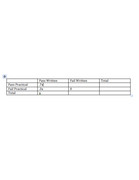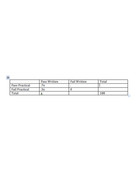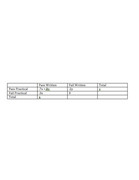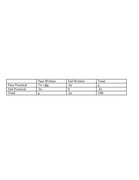To receive a driver license, sixteen year-olds at Culliver High School have to pass both a written and a practical driving test. Everyone has to take the tests, and no one failed both tests. If 30% of the 16 year-olds who passed the written test did not pass the practical, how many sixteen year-olds at Culliver High School received their driver license?
(1) There are 188 sixteen year-olds at Culliver High School.
(2) 20% of the sixteen year-olds who passed the practical test failed the written test.
DS 2 set question *can it be solved by testing it approach
This topic has expert replies
- rommysingh
- Master | Next Rank: 500 Posts
- Posts: 112
- Joined: Thu Mar 22, 2012 9:33 am
- Thanked: 1 times
- Followed by:1 members
- DavidG@VeritasPrep
- Legendary Member
- Posts: 2663
- Joined: Wed Jan 14, 2015 8:25 am
- Location: Boston, MA
- Thanked: 1153 times
- Followed by:128 members
- GMAT Score:770
Matrix! Let's call 'x' the number of students who passed the written exam. Given that .30x passed the written and did not pass the practical, and that nobody failed both, our initial matrix will look like this:To receive a driver license, sixteen year-olds at Culliver High School have to pass both a written and a practical driving test. Everyone has to take the tests, and no one failed both tests. If 30% of the 16 year-olds who passed the written test did not pass the practical, how many sixteen year-olds at Culliver High School received their driver license?
(1) There are 188 sixteen year-olds at Culliver High School.
(2) 20% of the sixteen year-olds who passed the practical test failed the written test.

Statement 1 tell us that there are 188 sixteen-year-olds in all. Now our matrix looks like this:

That won't tell us how many passed both tests. Not Sufficient.
Statement 2: Let's call the number of students who passed the practical test 'y.' Now we know that .2y passed the practical and failed the written and that .8y passed both. So there are two ways we can designate the "Passed practical/Passed written" cell, .7x and .8y. We now know that .7x = .8y. So our matrix will look like this:

We now have a ratio of y to x, (y/x = 7/8) but no values. Not Sufficient.
Together, our matrix will look like this:

Summing the bottom row, we have: x + .2y = 188. Summing the right-most column we have: y + .3x = 188. Two linear equations/two unknowns, so we can solve for our unknowns. If we can solve for x, we can solve for .7x. Together, the statements are sufficient. Answer is C
GMAT/MBA Expert
- Brent@GMATPrepNow
- GMAT Instructor
- Posts: 16207
- Joined: Mon Dec 08, 2008 6:26 pm
- Location: Vancouver, BC
- Thanked: 5254 times
- Followed by:1268 members
- GMAT Score:770
It's worth noting that David's Double Matrix approach can be used for most questions featuring a population in which each member has two characteristics associated with it.
Here, we have a population of sixteen-year-olds at Culliver High School, and the two characteristics are:
- passed the written test or did not pass the written test
- passed the practical driving test or did not pass the practical driving test
This question type is VERY COMMON on the GMAT, so be sure to master the technique.
To learn more about the Double Matrix Method, watch our free video: https://www.gmatprepnow.com/module/gmat- ... ems?id=919
Once you're familiar with this technique, you can attempt these additional practice questions:
Easy Problem Solving questions
- https://www.beatthegmat.com/the-aam-aadm ... 72242.html
- https://www.beatthegmat.com/finance-majo ... 67425.html
Medium Problem Solving questions
- https://www.beatthegmat.com/probability- ... 73360.html
- https://www.beatthegmat.com/posted-speed ... 72374.html
- https://www.beatthegmat.com/motel-t271938.html
- https://www.beatthegmat.com/of-the-appli ... 70255.html
- https://www.beatthegmat.com/opening-nigh ... 64869.html
- https://www.beatthegmat.com/ds-french-ja ... 22297.html
- https://www.beatthegmat.com/prblem-solving-t279424.html
Difficult Problem Solving questions
- https://www.beatthegmat.com/ratio-problem-t268339.html
- https://www.beatthegmat.com/overlapping- ... 65223.html
- https://www.beatthegmat.com/fractions-t264254.html
- https://www.beatthegmat.com/overlapping- ... 64092.html
- https://www.beatthegmat.com/mba/2011/05/ ... question-2
Easy Data Sufficiency questions
- https://www.beatthegmat.com/for-what-per ... 70596.html
- https://www.beatthegmat.com/ds-quest-t187706.html
Medium Data Sufficiency questions
- https://www.beatthegmat.com/sets-matrix-ds-t271914.html
- https://www.beatthegmat.com/each-of-peop ... 71375.html
- https://www.beatthegmat.com/a-manufacturer-t270331.html
- https://www.beatthegmat.com/in-costume-f ... 69355.html
- https://www.beatthegmat.com/mba/2011/05/ ... question-1
Difficult Data Sufficiency questions
- https://www.beatthegmat.com/double-set-m ... 71423.html
- https://www.beatthegmat.com/sets-t269449.html
- https://www.beatthegmat.com/mba/2011/05/ ... question-3
Cheers,
Brent
Here, we have a population of sixteen-year-olds at Culliver High School, and the two characteristics are:
- passed the written test or did not pass the written test
- passed the practical driving test or did not pass the practical driving test
This question type is VERY COMMON on the GMAT, so be sure to master the technique.
To learn more about the Double Matrix Method, watch our free video: https://www.gmatprepnow.com/module/gmat- ... ems?id=919
Once you're familiar with this technique, you can attempt these additional practice questions:
Easy Problem Solving questions
- https://www.beatthegmat.com/the-aam-aadm ... 72242.html
- https://www.beatthegmat.com/finance-majo ... 67425.html
Medium Problem Solving questions
- https://www.beatthegmat.com/probability- ... 73360.html
- https://www.beatthegmat.com/posted-speed ... 72374.html
- https://www.beatthegmat.com/motel-t271938.html
- https://www.beatthegmat.com/of-the-appli ... 70255.html
- https://www.beatthegmat.com/opening-nigh ... 64869.html
- https://www.beatthegmat.com/ds-french-ja ... 22297.html
- https://www.beatthegmat.com/prblem-solving-t279424.html
Difficult Problem Solving questions
- https://www.beatthegmat.com/ratio-problem-t268339.html
- https://www.beatthegmat.com/overlapping- ... 65223.html
- https://www.beatthegmat.com/fractions-t264254.html
- https://www.beatthegmat.com/overlapping- ... 64092.html
- https://www.beatthegmat.com/mba/2011/05/ ... question-2
Easy Data Sufficiency questions
- https://www.beatthegmat.com/for-what-per ... 70596.html
- https://www.beatthegmat.com/ds-quest-t187706.html
Medium Data Sufficiency questions
- https://www.beatthegmat.com/sets-matrix-ds-t271914.html
- https://www.beatthegmat.com/each-of-peop ... 71375.html
- https://www.beatthegmat.com/a-manufacturer-t270331.html
- https://www.beatthegmat.com/in-costume-f ... 69355.html
- https://www.beatthegmat.com/mba/2011/05/ ... question-1
Difficult Data Sufficiency questions
- https://www.beatthegmat.com/double-set-m ... 71423.html
- https://www.beatthegmat.com/sets-t269449.html
- https://www.beatthegmat.com/mba/2011/05/ ... question-3
Cheers,
Brent
- Max@Math Revolution
- Elite Legendary Member
- Posts: 3991
- Joined: Fri Jul 24, 2015 2:28 am
- Location: Las Vegas, USA
- Thanked: 19 times
- Followed by:37 members
Forget conventional ways of solving math questions. In DS, Variable approach is the easiest and quickest way to find the answer without actually solving the problem.
Remember equal number of variables and independent equations ensures a solution.
To receive a driver license, sixteen year-olds at Culliver High School have to pass both a written and a practical driving test. Everyone has to take the tests, and no one failed both tests. If 30% of the 16 year-olds who passed the written test did not pass the practical, how many sixteen year-olds at Culliver High School received their driver license?
(1) There are 188 sixteen year-olds at Culliver High School.
(2) 20% of the sixteen year-olds who passed the practical test failed the written test.
From the original condition we can obtain the below table. This is a typical 2by2 question that we commonly face in GMAT math test.
From the table, we have 3 variables (a,b,c) and 1 equation (30%=c/(a+b+c)) therefore we need 2 more equations to match the number of variables and equations. Since there is 1 each in 1) and 2), there is high probability that C is the answer. It turns out that C actually is the answer.
Normally for cases where we need 2 more equations, such as original conditions with 2 variable, or 3 variables and 1 equation, or 4 variables and 2 equations, we have 1 equation each in both 1) and 2). Therefore C has a high chance of being the answer, which is why we attempt to solve the question using 1) and 2) together. Here, there is 70% chance that C is the answer, while E has 25% chance. These two are the key questions. In case of common mistake type 3,4, the answer may be from A, B or D but there is only 5% chance. Since C is most likely to be the answer according to DS definition, we solve the question assuming C would be our answer hence using ) and 2) together. (It saves us time). Obviously there may be cases where the answer is A, B, D or E.
Math Revolution : Finish GMAT Quant Section with 10 minutes to spare
The one-and-only World's First Variable Approach for DS and IVY Approach for PS with ease, speed and accuracy.
Unlimited Access to over 120 free video lessons - try it yourself (https://www.mathrevolution.com/gmat/lesson)
See our Youtube demo (https://www.youtube.com/watch?v=R_Fki3_2vO8)
Remember equal number of variables and independent equations ensures a solution.
To receive a driver license, sixteen year-olds at Culliver High School have to pass both a written and a practical driving test. Everyone has to take the tests, and no one failed both tests. If 30% of the 16 year-olds who passed the written test did not pass the practical, how many sixteen year-olds at Culliver High School received their driver license?
(1) There are 188 sixteen year-olds at Culliver High School.
(2) 20% of the sixteen year-olds who passed the practical test failed the written test.
From the original condition we can obtain the below table. This is a typical 2by2 question that we commonly face in GMAT math test.
From the table, we have 3 variables (a,b,c) and 1 equation (30%=c/(a+b+c)) therefore we need 2 more equations to match the number of variables and equations. Since there is 1 each in 1) and 2), there is high probability that C is the answer. It turns out that C actually is the answer.
Normally for cases where we need 2 more equations, such as original conditions with 2 variable, or 3 variables and 1 equation, or 4 variables and 2 equations, we have 1 equation each in both 1) and 2). Therefore C has a high chance of being the answer, which is why we attempt to solve the question using 1) and 2) together. Here, there is 70% chance that C is the answer, while E has 25% chance. These two are the key questions. In case of common mistake type 3,4, the answer may be from A, B or D but there is only 5% chance. Since C is most likely to be the answer according to DS definition, we solve the question assuming C would be our answer hence using ) and 2) together. (It saves us time). Obviously there may be cases where the answer is A, B, D or E.
Math Revolution : Finish GMAT Quant Section with 10 minutes to spare
The one-and-only World's First Variable Approach for DS and IVY Approach for PS with ease, speed and accuracy.
Unlimited Access to over 120 free video lessons - try it yourself (https://www.mathrevolution.com/gmat/lesson)
See our Youtube demo (https://www.youtube.com/watch?v=R_Fki3_2vO8)
- Attachments
-




















